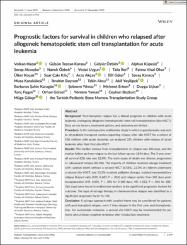Prognostic factors for survival in children who relapsed after allogeneic hematopoietic stem cell transplantation for acute leukemia

Göster/
Erişim
info:eu-repo/semantics/embargoedAccessTarih
2021Yazar
Hazar, VolkanTezcan Karasu, Gülsün
Öztürk, Gülyüz
Küpesiz, Alphan
Aksoylar, Serap
Özbek, Namık
Uygun, Vedat
İleri, Talia
Visal Okur, Fatma
Koçak, Ülker
Çakı Kılıç, Suar
Akçay, Arzu
Güler, Elif
Kansoy, Savaş
Karakükcü, Musa
Bayram, İbrahim
Aksu, Tekin
Yeşilipek, Akif
Karagün, Barbaros Şahin
Yılmaz, Şebnem
Ertem, Mehmet
Uçkan, Duygu
Fışgın, Tunç
Gürsel, Orhan
Yaman, Yöntem
Bozkurt, Ceyhun
Gökçe, Müge
Üst veri
Tüm öğe kaydını gösterKünye
Hazar, V., Tezcan Karasu, G., Öztürk, G., Küpesiz, A., Aksoylar, S., Özbek, N. ... Gökçe, M. (2021). Prognostic factors for survival in children who relapsed after allogeneic hematopoietic stem cell transplantation for acute leukemia. Pediatric Transplantation, 25(5). https://dx.doi.org/10.1111/petr.13942Özet
Background Post-transplant relapse has a dismal prognosis in children with acute leukemia undergoing allogeneic hematopoietic stem cell transplantation (allo-HSCT). Data on risk factors, treatment options, and outcomes are limited.
Procedure In this retrospective multicenter study in which a questionnaire was sent to all pediatric transplant centers reporting relapse after allo-HSCT for a cohort of 938 children with acute leukemia, we analyzed 255 children with relapse of acute leukemia after their first allo-HSCT.
Results The median interval from transplantation to relapse was 180 days, and the median follow-up from relapse to the last follow-up was 1844 days. The 3-year overall survival (OS) rate was 12.0%. The main cause of death was disease progression or subsequent relapse (82.6%). The majority of children received salvage treatment with curative intent without a second HSCT (67.8%), 22.0% of children underwent a second allo-HSCT, and 10.2% received palliative therapy. Isolated extramedullary relapse (hazard ratio (HR): 0.607, P = .011) and relapse earlier than 365 days post-transplantation (HR: 2.101, P < .001 for 0-180 days; HR: 1.522, P = .041 for 181-365 days) were found in multivariate analysis to be significant prognostic factors for outcome. The type of salvage therapy in chemosensitive relapse was identified as a significant prognostic factor for OS.
Conclusion A salvage approach with curative intent may be considered for patients with post-transplant relapse, even if they relapse in the first year post-transplantation. For sustainable remission, a second allo-HSCT may be recommended for patients who achieve complete remission after reinduction treatment.
WoS Q Kategorisi
Q4Scopus Q Kategorisi
Q2Kaynak
Pediatric TransplantationCilt
25Sayı
5Koleksiyonlar
- Makale Koleksiyonu [3777]
- PubMed İndeksli Yayınlar Koleksiyonu [4230]
- Scopus İndeksli Yayınlar Koleksiyonu [6574]
- WoS İndeksli Yayınlar Koleksiyonu [6631]

















